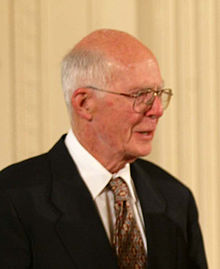Raymond Davis Jr.
| Raymond Davis Jr. | |
|---|---|

Davis in 2001
|
|
| Born |
October 14, 1914 Washington, D.C., United States |
| Died | May 31, 2006 (aged 91) Blue Point, New York, United States |
| Nationality | American |
| Fields | Chemistry, physics |
| Institutions |
Monsanto University of Pennsylvania |
| Alma mater |
University of Maryland Yale University |
| Known for | Neutrinos |
| Notable awards | (1978) Tom W. Bonner Prize (1988) Beatrice M. Tinsley Prize (1994) Wolf Prize in Physics (2000) National Medal of Science (2001) Nobel Prize in Physics (2002) Enrico Fermi Award (2003) |
Raymond (Ray) Davis Jr. (October 14, 1914 – May 31, 2006) was an American chemist, physicist, and Nobel Prize in Physics laureate.
Davis was born in Washington, D.C., where his father was a photographer for the National Bureau of Standards. He spent several years as a choirboy to please his mother, although he could not carry a tune. He enjoyed attending the concerts at the Watergate before air traffic was loud enough to drown out the music. His brother Warren, 14 months younger than he, was his constant companion in boyhood. He received his B.S. from the University of Maryland in 1938 in chemistry, which is part of the University of Maryland College of Computer, Mathematical, and Natural Sciences. He also received a master's degree from that school and a Ph.D. from Yale University in physical chemistry in 1942.
Davis spent most of the war years at Dugway Proving Ground, Utah observing the results of chemical weapons tests and exploring the Great Salt Lake basin for evidence of its predecessor, Lake Bonneville.
Upon his discharge from the army in 1946, Davis went to work at Monsanto's Mound Laboratory, in Miamisburg, Ohio, doing applied radiochemistry of interest to the United States Atomic Energy Commission. In 1948, he joined Brookhaven National Laboratory, which was dedicated to finding peaceful uses for nuclear power.
...
Wikipedia
